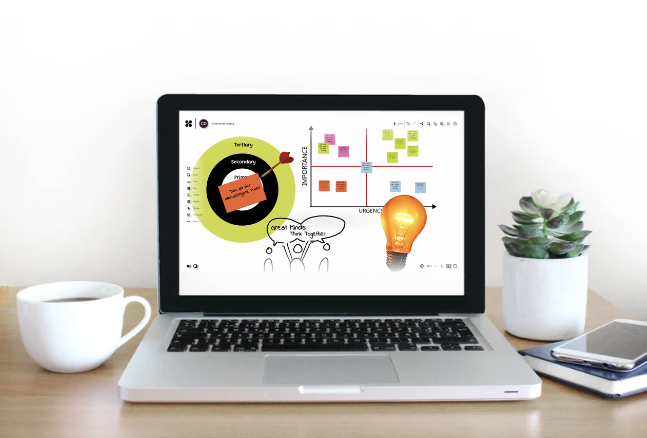What does hybrid working mean? Why has hybrid working become so popular and a buzzword that has become an integral part of many companies' marketing plumes?
The reason is simple and an analogy to plant breeding illustrates this very well. The goal of many breeding programs is to create new plants that produce the highest possible yields. For this purpose, plants are crossed and so-called hybrids are created, each of which retains the best characteristics of the parent generation.
|
Hybrid working is about combining the best parts of the two different ways of working, "remote first" and "office first", into a hybrid working model - with the aim of increasing productivity. Productivity depends on many factors for today's knowledge workers, who spend most of their working day sitting in front of a computer. While hybrid working was a niche activity a few years ago, since the Corona pandemic it has become clear to most that hybrid working also brings numerous benefits that have a positive impact on productivity. Due to the home office obligation during the pandemic, most people were able to experience the advantages and disadvantages of hybrid working first hand. The disruptive change in the world of work has greatly increased the need for more flexible ways of working. Companies that offer hybrid work models allow employees to flexibly arrange their work location and working hours. How flexible location and time are is often individual for each company and depends on the activities performed. What hybrid work models are there and what are the differences in terms of work model flexibility? |
|
ContentFlexibility of the working locationAdvantages & disadvantages of hybrid working |
||
📍Flexibility of the working location
| Remote First: Work is primarily done remotely and not in the office. In many cases, an office only exists to a limited extent. Teams mainly meet online when they work together. | Partially Flexible: Certain fixed times are defined when employees must be in the office. Outside the fixed times (often individual days), employees can decide for themselves where they work from. |
Fully Flexible: Employees are free to work from wherever they choose, but have the option to meet and work from a shared office. |
Office First: The main part of the work is done in the office. Home office or working from other locations is only the exception. |
⏰ Flexibility of working time
How flexible the working time can be chosen depends strongly on the type of activity and how much teamwork it involves. Especially if the activity requires a lot of synchronous collaboration, flexibility is limited. Activities that can be performed completely independently or in which collaboration takes place mainly asynchronously can be performed at very flexible times.
| Fully Flexible: Employees can decide for themselves when they work. |
Partially Flexible: Employees can decide for themselves when they work, but must be available during certain core hours. |
Fixed: The working time is precisely regulated. |
If you now take the flexibility of time and place for a job and combine them, then we talk about hybrid working. Always with the idea of combining the best of two worlds to increase productivity.
Advantages & disadvantages of hybrid working
Why should companies and organizations enable hybrid working?
The answer is quite simple - because it is a great need for many employees!
Advantages of hybrid working
- Employees' need for more flexibility in when and where they work is taken into account. This leads to employees being more satisfied, as they can better integrate their work and private (better work-life balance).
- Lower costs for office space, as less space per employee usually needs to be provided.
- Better opportunities to attract new employees. On the one hand, hybrid work models make employers look more attractive, and on the other hand, they expand the radius from which employees can come. Since less work is done in the office, longer commutes can be accepted.
- Better opportunities to attract new employees. On the one hand, hybrid work models make employers look more attractive, and on the other hand, they expand the radius from which employees can come. Since less work is done in the office, longer commutes can be accepted.
Disadvantages of hybrid working
It is difficult to define what disadvantages companies have when employees work hybrid. As a rule, this depends heavily on how hybrid working is implemented and what resources are available for this purpose.
If hybrid working is implemented optimally and all employees have the necessary skills, then hybrid working has only minor negative effects. For this reason, we show here the risks that companies take when they enable hybrid working with a lot of flexibility.
- Innovation Risk
Fewer physical workshops, meetings, cafeteria conversations, or shared after-work beers have a negative impact on organizational innovation. This impact occurs most strongly in the remote-first approach. - Technology Risks
Two risks associated with technology need to be considered. The risk that technology will not work or has been incorrectly selected, or that technology will not be used properly by employees. - Social Risks
In the hybrid work model, work and private life are becoming increasingly intermingled, as there is less strict separation. In addition, the expectation often arises that people are always online when working hours are not fixed.
Interpersonal exchange takes place less in hybrid working. When people don't physically meet, social conversations are often omitted. Digital small talk is usually shorter than analog small talk.
How & with what to implement hybrid work models?
For hybrid working to be implemented effectively, it requires certain prerequisites. It is only possible if companies and employees complement each other. For example, employees must manage their own workstations at home or select the right co-working space.
For example, you should not have meetings on the train or in a public cafeteria where trade secrets are discussed.
Companies can help to ensure that hybrid working leads to the desired success primarily through the selection of technology, the empowerment of employees and appropriate guidelines.
Technology of the hybrid workplace
- with focus on online whiteboard
In the following, we take a look at the purposes for which software solutions are needed to create the right conditions for the hybrid workplace.
Solutions are needed for the following use cases, among others:
- Hoteling Software for reserving workstations and conference rooms
- Productivity tools like Microsoft 365, Google Workspace
- Planning software for task management and project planning
- Messaging tools for chatting and quick file sharing
- Audio & video conferencing solutions for digital calling and holding online meetings with video
- Online whiteboards for hybrid meetings, digital workshop formats and creative teamwork
Depending on the industry and the size of the company, numerous other solutions may become relevant.
 |
Online whiteboards in the context of the hybrid workplaceThe online whiteboard brings numerous analog tools from meeting and workshop rooms into the digital world. Flipcharts, whiteboards and entire project rooms can be digitized with an online whiteboard. With the digital flipchart and method case, there are no more limits to digital collaboration. digital collaboration no longer has any limits. |
|
Online meetings become more than just video conferencing
A few months ago, the term "zoom fatigue" emerged because people spent a lot of time in video conferences during lock-downs and home office duties. When these videoconferences are all talk and individuals share the screen, there is rarely a collaborative atmosphere that makes people feel like they are creating something together.
This is exactly where the online whiteboard comes in. It makes digital meetings more interactive, more diverse, and helps teams create collaborative results. Away from screen sharing, towards real-time collaboration on an infinite virtual surface that brings a breath of fresh air to any online meeting.
By being able to present directly in the online whiteboard, screen sharing is increasingly eliminated, reducing media disruption in online meetings.
Hybrid workshops where all content is created digitally
The online whiteboard is the digital method case. With it, tried and tested workshop formats from the analog world can be easily digitized. The great advantage of working digitally in workshops is that at the end of the day there is no need to create photo protocols in time-consuming work.
In addition, hybrid workshop formats require less office space and workshop rooms. Because content is created regardless of location and is available at any time, workshops can be more dynamic. It becomes easier and more convenient to continue a workshop on a second date.
Especially the agile, iterative approach, which many companies and authorities are currently discovering for themselves, benefits enormously from an online whiteboard platform.
For example, the use of an online whiteboard in hybrid workshop formats can look like this ▶▶
The setup for the hybrid workshop
|
On-site team The on-site team meets in the reserved meeting room, which is equipped with an audio and video conferencing system and, in the best case, also contains a large, interactive display. |
|
Remote Participants Remote participants are those who are sitting at home, in a co-working space or somewhere else and participate in the workshop. |
 |
Creative activities implemented digitally
New ideas and approaches take us further in life and in everyday business. With an online whiteboard, the process of generating ideas can be moved into the digital world. People become much more creative when they write their ideas on digital post-its instead of simply posting them to the chat of a video conferencing solution.
Especially various brainstorming and mind mapping methods can be implemented very nicely with an online whiteboard.
By using an online whiteboard, they ensure that their employees are always looking for creative solution ideas, develop new products and services, and thus strengthen the innovative power of the company.
Visualization of knowledge & processes
Processes and interrelationships are becoming increasingly complex. It is becoming increasingly difficult to describe these in pure text form and to understand them when reading. In recent years, we have become more and more accustomed to visuals and graphics, while our affinity for texts is declining.
The visualization of knowledge, contexts and processes can be easily and effectively implemented with an online whiteboard. The beauty is that an online whiteboard is not a complex visualization software, which requires appropriate training until it can be used successfully. The functionality is so intuitive that the creative process is not slowed down but encouraged.
Online whiteboards are inclusive solutions, where everyone can quickly join in and together visualize the knowledge that exists in their heads.
Of course, there are numerous other possible uses for an online whiteboard in a hybrid work context. Many don't yet know exactly where the journey will take them with the hybrid workplace and it's a constant trial, learn and improve.
If you would like to draw on over 6 years of experience using an online whiteboard, please feel free to contact us. We will be happy to show you the possibilities, advise you on how an online whiteboard can be used in your organization and support you in the process of digitization.
In addition to the deployment scenarios and methodological input, we will also provide you with comprehensive advice on the subject of data protection, so that you can find a solution that meets the level of security you require.
|
You work for a public authority and need specific input to optimize your cooperation? (GERMAN ONLY) ▶▶
|
.jpg?width=536&name=lp_zwischenbild%20(1).jpg)
|



